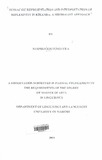| dc.description.abstract | This work is primarily concerned with how reflexivity in Kikamba is syntactically represented and interpreted using Derivation by Phase theory of the Minimalist Program. The study specifically deals with the various strategies that are used in expressing reflexivity in Kikarnba together with the special role played by the Reflexive Marker (RFM) in encoding reflexivity. The RFM is analyzed alongside the Object Marker (OM) in order to bring out the grammatical features, that license its treatment as an argument. The RFM, according to this study is understood as an incorporated object. Therefore, it should have <p-features (person and number) that should match with those of the antecedent. These features facilitate the interpretation of the RFM as being co-referential with the antecedent. In addition to the RFM, other ways of marking reflexivity such as the object null and the free pronominal strategies are discussed in this work.
The Derivation by Phase model adopted in this study accounts for the feature valuation and feature deletion. This is done through structure building that is triggered by the twin operations of merge and move. A case-assigning head v triggers movement that raises the RFM from the VP internal argument position to [spec, vP] for accusative case assignment. It is logically assumed that the RFM should receive case by virtue of being an incorporated object. T assigns case to the external argument and it moves from the [spec, vl'] to [spec, TP1 for nominative case marking and EPP satisfaction. The referential feature [REF] on both the anaphor and the antecedent by way of' Agree' binds the RFM to its antecedent subject.
This study covers five chapters. Chapter one provides general background information of Kikarnba as pertains to genetic affi liation. Attention is specifically given to the research problem, which paves way to the research questions, guiding objectives and hypotheses. Other areas covered in this chapter include rationale, scope and limitations, significance of this study, theoretical framework, literature review and research methodology.
Chapter two describes the Kikamba Verb Phrase, focusing on the interrelatedness of the RFM and the OM. The syntactic properties of the RFM as a key player in reflexivity are also discussed. The RFM is realized as an object marker and pronominal. Its role in verb and reflexive nominalization as well as in the licensing conditions and agreement patt~e also discussed in this chapter Chapter three presents a detailed analysis of the different strategies that are used to mark reflexivity in Klkamba. Three such strategies are discussed. These are the Primary Reflexive Marking Strategy, the Object Null and the free pronominal Strategy.
Chapter four is an application of the theory to reflexivity. The theory used here IS Derivation by Phase. 'Merge' and 'Move' are the two major operations that facilitate the computation in this theory. Probes and goals are used for this purpose. The third operation 'Agree', ensures feature valuation and feature deletion for interpretabi lity at spell-out.
Chapter five provides a conclusive summary on the research findings regarding the research study objectives and hypotheses. In addition, recommendations on areas that in literature review require more research are given at the end of this chapter. | en_US |


